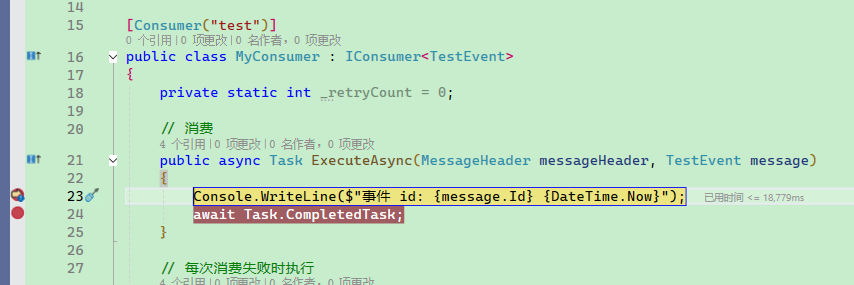快速开始
在本篇教程中,将介绍 Maomi.MQ.RabbitMQ 的使用方法,以便读者能够快速了解该框架的使用方式和特点。
创建一个 Web 项目(可参考 WebDemo 项目),引入 Maomi.MQ.RabbitMQ 包,在 Web 配置中注入服务:
// using Maomi.MQ;
// using RabbitMQ.Client;
builder.Services.AddMaomiMQ((MqOptionsBuilder options) =>
{
options.WorkId = 1;
options.AppName = "myapp";
options.Rabbit = (ConnectionFactory options) =>
{
options.HostName = Environment.GetEnvironmentVariable("RABBITMQ")!;
options.Port = 5672;
options.ClientProvidedName = Assembly.GetExecutingAssembly().GetName().Name;
};
}, [typeof(Program).Assembly]);
var app = builder.Build();
WorkId: 指定用于生成分布式雪花 id 的节点 id,默认为 0。
每条消息生成一个唯一的 id,便于追踪。如果不设置雪花id,在分布式服务中,多实例并行工作时,可能会产生相同的 id。
AppName:用于标识消息的生产者,以及在日志和链路追踪中标识消息的生产者或消费者。
Rabbit:RabbitMQ 客户端配置,请参考 ConnectionFactory。
定义消息模型类,模型类是 MQ 通讯的消息基础,该模型类将会被序列化为二进制内容传递到 RabbitMQ 服务器中。
public class TestEvent
{
public int Id { get; set; }
public override string ToString()
{
return Id.ToString();
}
}
定义消费者,消费者需要实现 IConsumer<TEvent> 接口,以及使用 [Consumer] 特性注解配置消费者属性,如下所示,[Consumer("test")] 表示该消费者订阅的队列名称是 test。
IConsumer<TEvent> 接口有三个方法,ExecuteAsync 方法用于处理消息,FaildAsync 会在 ExecuteAsync 异常时立即执行,如果代码一直异常,最终会调用 FallbackAsync 方法,Maomi.MQ 框架会根据 ConsumerState 值确定是否将消息放回队列重新消费,或者做其它处理动作。
[Consumer("test")]
public class MyConsumer : IConsumer<TestEvent>
{
// 消费
public async Task ExecuteAsync(MessageHeader messageHeader, TestEvent message)
{
Console.WriteLine($"事件 id: {message.Id} {DateTime.Now}");
await Task.CompletedTask;
}
// 每次消费失败时执行
public Task FaildAsync(MessageHeader messageHeader, Exception ex, int retryCount, TestEvent message)
=> Task.CompletedTask;
// 补偿
public Task<ConsumerState> FallbackAsync(MessageHeader messageHeader, TestEvent? message, Exception? ex)
=> Task.FromResult( ConsumerState.Ack);
}
Maomi.MQ 还具有多种消费者模式,代码写法不一样,后续会详细讲解不同的消费者模式。
如果要发布消息,只需要注入 IMessagePublisher 服务即可。
[ApiController]
[Route("[controller]")]
public class IndexController : ControllerBase
{
private readonly IMessagePublisher _messagePublisher;
public IndexController(IMessagePublisher messagePublisher)
{
_messagePublisher = messagePublisher;
}
[HttpGet("publish")]
public async Task<string> Publisher()
{
// 发布消息
await _messagePublisher.PublishAsync(exchange: string.Empty, routingKey: "test", message: new TestEvent
{
Id = 123
});
return "ok";
}
}
启动 Web 服务,在 swagger 页面上请求 API 接口,MyConsumer 服务会立即接收到发布的消息。

如果是控制台项目,则需要引入 Microsoft.Extensions.Hosting 包,以便让消费者在后台订阅队列消费消息。
参考 ConsoleDemo 项目。
using Maomi.MQ;
using Microsoft.Extensions.Hosting;
using Microsoft.Extensions.Logging;
using RabbitMQ.Client;
using System.Reflection;
var host = new HostBuilder()
.ConfigureLogging(options =>
{
options.AddConsole();
options.AddDebug();
})
.ConfigureServices(services =>
{
services.AddMaomiMQ(options =>
{
options.WorkId = 1;
options.AppName = "myapp";
options.Rabbit = (ConnectionFactory options) =>
{
options.HostName = Environment.GetEnvironmentVariable("RABBITMQ")!;
options.Port = 5672;
options.ClientProvidedName = Assembly.GetExecutingAssembly().GetName().Name;
};
}, new System.Reflection.Assembly[] { typeof(Program).Assembly });
}).Build();
// 后台运行
var task = host.RunAsync();
Console.ReadLine();